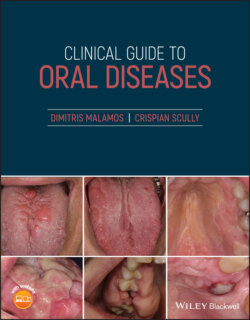Читать книгу Clinical Guide to Oral Diseases - Crispian Scully - Страница 37
Case 3.1
ОглавлениеFigure 3.1
CO: A 43‐year‐old woman was evaluated for multiple brown lesions scattered in her mouth.
HPC: The brown lesions were first noticed by her dentist 10 years ago, but had remained unchanged since then. The lesions were asymptomatic and did not cause any patient concern until two years ago when she lost her sister from lung cancer and started her menopause.
PMH: She suffered from carpal tunnel syndrome on her right hand, exacerbated due to her job as a secretary and allergic keratitis on both eyes relieved with steroid eye drops (in crisis). She used no other medications or other known allergies. She was a chronic smoker of 8–10 cigarettes daily, and an occasional drinker.
OE: A middle‐aged lady with dark complexion, with no other lesions on her mouth apart from a few pigmented brown lesions on her gingivae, buccal mucosae, floor of the mouth (Figure 3.1) and lips. The discoloration was more obvious on the gums and floor of the mouth. No other lesions were found on her skin or other mucosae. Blood pressure and hormone tests were within the normal range.
Q1 What is the cause of the discoloration?
1 Addison's disease
2 Racial pigmentation
3 Drug‐induced discoloration
4 Heavy metal poisoning
5 Melasma
Answers:
1 No
2 Racial pigmentation is a common condition among darker skinned individuals, and is presented as multifocal brown to black discoloration of gingivae (mainly) but also the tongue (dorsum and inferior) (Figure 3.1), floor of the mouth and soft palate. This discoloration is the result of increased production of melanin pigment by normal melanocytes.
3 No
4 No
5 No
Comments: Brown pigmentation is the result of increased melanin production and deposition in the melanocytes of the basal layers of the epithelium. Apart from racial pigmentation other conditions may be the cause such as Addison's disease, melasma, heavy metals, or drug effects. Drugs induced or metal poisoning pigmentation was easily discounted as the patient did not take any causative drugs nor was she exposed to chemicals in her hob or at home.. In melasma, the pigmentation is limited to facial skin and never involves the oral mucosa, and it mainly appears in young women during pregnancy. Normal blood pressure and Na, K, Ca, and cortisol levels as well as a normal Synacthen test excludes Addison's disease from the diagnosis.
Q2 Which are the histological characteristics of racial pigmentation?
1 Increased production of melanin from an adequate number of melanocytes
2 Increased number of melanocytes at the basal layer
3 Presence of melanophages within the superficial lamina propria
4 Atrophic epithelium
5 Reduced number of melanocytes
Answers:
1 Racial pigmentation is connected with the increased production of melanin from melanocytes at the basal layer which is transported to adjoining keratinocytes through membrane‐bound organelles known as melanocytes.
2 No
3 Melanophages are macrophages within the upper corium containing melanin.
4 No
5 No
Comments: The brown discoloration is the result of increased melanin production in normal or increased number of melanocytes. The brightness or not of this discoloration depends on the epithelial thickness’ atrophic epithelium presents melanin pigment closer to the examiners’ eyes,
Q3 In which other parts of the human body apart from the mouth is melanin commonly found?
1 Heart
2 Skin and its appendages (hairs/nails)
3 Brain
4 Joint cartilage
5 Eyes
Answers:
1 Heart valves, aortic sinuses and coronary vessels are often found with increased melanin pigmentation induced by antibiotics such as minocycline.
2 Increased skin pigmentation is often seen among patients with dark complexion and nails (melanonychia) or in patients exposed to solar radiation (solar dermatitis, lentigines, freckles), or in chronic inflammation (lichen planus), and hormone changes (melasma). Hair pigmentation is the result of sequential interaction between follicular melanocytes, matrix keratinocytes and dermal papillae fibroblasts. Hair color is also based on the ratio between eumelanin and pheomelanin. The higher the level of eumelanin, the darker the hair.
3 Brain pigmentation is seen in catecholaminergic cells of the substantia nigra of the brain and is caused by the accumulation of neuromelanin (one of the three components of melanin), the role of which remains obscure.
4 No
5 Eye color is the result of iris pigmentation, as dark brown eyes have a higher quantity of melanin than blue eyes.
Comments: Cartilage pigmentation is rarely seen and is associated with the accumulation of homogentisic acid rather than melanin in the connective tissues of nails, cartilage and bones.
